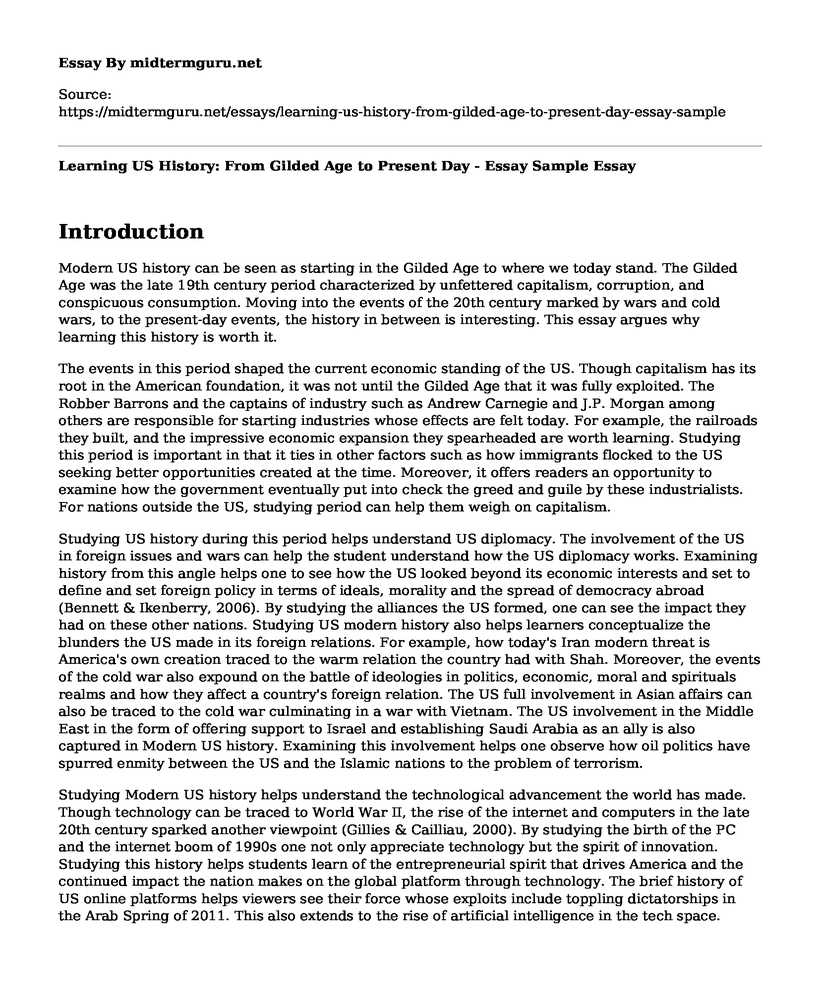Introduction
Modern US history can be seen as starting in the Gilded Age to where we today stand. The Gilded Age was the late 19th century period characterized by unfettered capitalism, corruption, and conspicuous consumption. Moving into the events of the 20th century marked by wars and cold wars, to the present-day events, the history in between is interesting. This essay argues why learning this history is worth it.
The events in this period shaped the current economic standing of the US. Though capitalism has its root in the American foundation, it was not until the Gilded Age that it was fully exploited. The Robber Barrons and the captains of industry such as Andrew Carnegie and J.P. Morgan among others are responsible for starting industries whose effects are felt today. For example, the railroads they built, and the impressive economic expansion they spearheaded are worth learning. Studying this period is important in that it ties in other factors such as how immigrants flocked to the US seeking better opportunities created at the time. Moreover, it offers readers an opportunity to examine how the government eventually put into check the greed and guile by these industrialists. For nations outside the US, studying period can help them weigh on capitalism.
Studying US history during this period helps understand US diplomacy. The involvement of the US in foreign issues and wars can help the student understand how the US diplomacy works. Examining history from this angle helps one to see how the US looked beyond its economic interests and set to define and set foreign policy in terms of ideals, morality and the spread of democracy abroad (Bennett & Ikenberry, 2006). By studying the alliances the US formed, one can see the impact they had on these other nations. Studying US modern history also helps learners conceptualize the blunders the US made in its foreign relations. For example, how today's Iran modern threat is America's own creation traced to the warm relation the country had with Shah. Moreover, the events of the cold war also expound on the battle of ideologies in politics, economic, moral and spirituals realms and how they affect a country's foreign relation. The US full involvement in Asian affairs can also be traced to the cold war culminating in a war with Vietnam. The US involvement in the Middle East in the form of offering support to Israel and establishing Saudi Arabia as an ally is also captured in Modern US history. Examining this involvement helps one observe how oil politics have spurred enmity between the US and the Islamic nations to the problem of terrorism.
Studying Modern US history helps understand the technological advancement the world has made. Though technology can be traced to World War II, the rise of the internet and computers in the late 20th century sparked another viewpoint (Gillies & Cailliau, 2000). By studying the birth of the PC and the internet boom of 1990s one not only appreciate technology but the spirit of innovation. Studying this history helps students learn of the entrepreneurial spirit that drives America and the continued impact the nation makes on the global platform through technology. The brief history of US online platforms helps viewers see their force whose exploits include toppling dictatorships in the Arab Spring of 2011. This also extends to the rise of artificial intelligence in the tech space.
Based on these three reasons, the economic standing of the US, technology advancement and foreign policy, studying modern US history is worth it. It helps in understanding the problems we face today and informs of what we ought to appreciate.
References
Bennett, A., & Ikenberry, G. J. (2006). The Review's Evolving Relevance for U.S. Foreign Policy 1906-2006. American Political Science Review, 100(04), 651. doi:10.1017/s000305540606254x
Gillies, J. M., & Cailliau, R. (2000). How the Web was Born: The Story of the World Wide Web. New York, NY: Oxford University Press, USA.
Cite this page
Learning US History: From Gilded Age to Present Day - Essay Sample. (2023, Feb 02). Retrieved from https://midtermguru.com/essays/learning-us-history-from-gilded-age-to-present-day-essay-sample
If you are the original author of this essay and no longer wish to have it published on the midtermguru.com website, please click below to request its removal:
- Professional Sports Ticket Prices and the Market - Essay Example
- History Essay Sample: Indians Wars
- Discussions on Political Economy - Paper Example
- What Happened to Abigail Williams - Essay Sample
- Research Paper on Resilience
- Canopic Jars: An Ancient Egyptian Tradition for Mummification - Essay Sample
- Monetary and Fiscal Policy - Essay Sample







